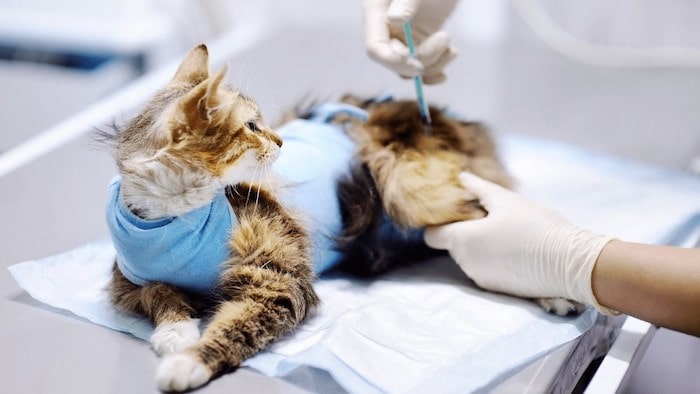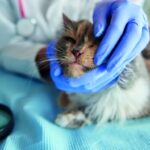As responsible pet owners, it’s crucial to ensure our feline companions are protected from preventable diseases, and the FVRCP vaccine plays a vital role in safeguarding their health.
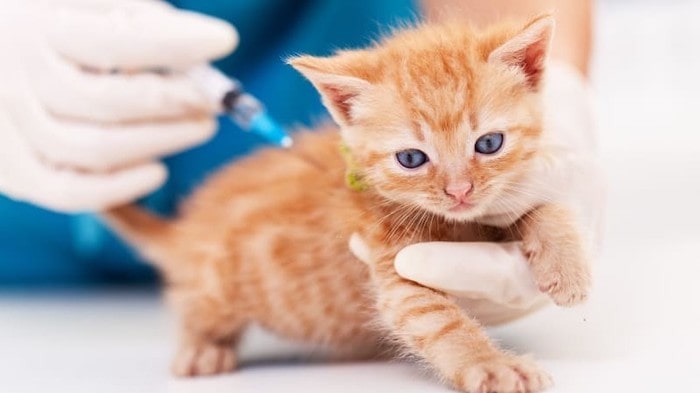
In this article, we’ll cover everything you need to know about the FVRCP vaccination, from what it protects against to its importance, administration, and potential side effects.
Whether you’re a new cat owner or simply seeking to refresh your knowledge, we’ve got you covered. Let’s get started on the journey to a healthier and happier life for your beloved furball!
What is the FVRCP vaccine and why is it important for cats?
The FVRCP vaccine is a combination vaccine for cats that protects against three different diseases:
Feline Viral Rhinotracheitis (FVR)
Feline viral rhinotracheitis (FVR) is a disease caused by feline herpesvirus 1 (FHV-1). FVR can cause symptoms such as sneezing, runny nose, watery eyes, fever, and loss of appetite. In some cases, FVR can lead to secondary bacterial infections that can affect the cat’s breathing and even be life-threatening.
According to Malcolm Weir, DVM at VCA Hospitals, “FVR is a major cause of upper respiratory disease in cats and is the most common cause of conjunctivitis (inflammation of the tissues surrounding the eye, especially the lining of the lids and the third eyelid).”
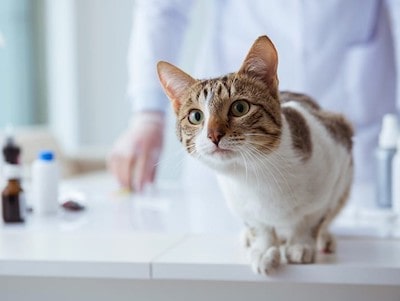
FVR is highly contagious and can spread through direct contact with infected cats or through the environment. Once a cat is infected with FHV-1, the virus stays in the body for life and can reactivate during times of stress or illness. This means that cats with FVR can have recurrent episodes of symptoms throughout their lives.
There is no cure for FVR, but there are treatments that can help reduce the severity and duration of symptoms. These include antibiotics for secondary infections, antiviral medications, eye drops, and supportive care. However, the best way to prevent FVR is by vaccinating your cat with the FVRCP vaccine.
Feline Calicivirus (FCV)
Feline calicivirus (FCV)[1] is another common cause of upper respiratory infections in cats. FCV can cause similar symptoms as FVR, such as sneezing, runny nose, watery eyes, and fever. However, FCV can also cause ulcers in the mouth, joint swelling, limping, and chronic stomatitis (inflammation of the mouth).
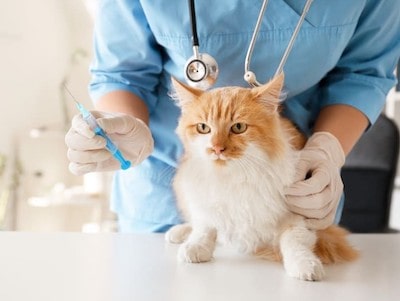
FCV is also highly contagious and can spread through direct contact with infected cats or through the environment. Unlike FHV-1, FCV does not stay in the body for life, but it can mutate and create different strains that can infect cats again. Some strains of FCV can cause a more severe disease called virulent systemic feline calicivirus (VS-FCV), which can affect the internal organs and be fatal.
There is no cure for FCV, but there are treatments that can help manage the symptoms and prevent complications. These include antibiotics for secondary infections, pain medications, anti-inflammatory drugs, and supportive care. However, the best way to prevent FCV is by vaccinating your cat with the FVRCP vaccine
Feline Panleukopenia (FPV)
Feline panleukopenia (FPV) [2], also known as feline distemper or feline parvovirus, is a serious disease that affects the gastrointestinal tract and immune system of cats. FPV can cause symptoms such as vomiting, diarrhea, dehydration, anorexia, fever, and lethargy. FPV can also damage the bone marrow and lymph nodes, which leads to a very low white blood cell count and makes the cat vulnerable to secondary infections.
FPV is extremely contagious and can spread through direct contact with infected cats or through contaminated objects or environments. FPV can survive in the environment for a long time and resist many disinfectants. FPV can infect cats of any age, but kittens are especially at risk. FPV has a high mortality rate and many cats die within days of infection.
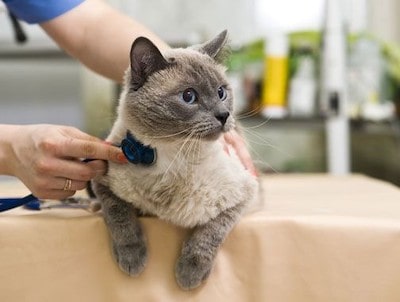
There is no cure for FPV, but there are treatments that can help support the cat’s recovery. These include fluids for dehydration, antibiotics for secondary infections, blood transfusions for anemia, and supportive care. However, the best way to prevent FPV is by vaccinating your cat with the FVRCP vaccine.
All three of these viruses are highly contagious and can spread through direct contact with infected cats or their secretions, or through contaminated objects or environments. They can also cause lifelong infections in cats that survive them, and may recur or cause chronic problems. There is no specific treatment or cure for these viruses, only supportive care and symptom management.
The FVRCP vaccine is considered a core vaccine for cats, meaning that it is strongly recommended for all cats, regardless of their lifestyle or risk factors. The World Small Animal Veterinary Association says, “Core vaccines protect animals from severe, life-threatening diseases that have global distributions.”
The FVRCP vaccine can help prevent these diseases, or reduce their severity and complications if they do occur. By vaccinating your cat against these viruses, you are not only protecting your cat’s health, but also reducing the spread of these diseases in the cat population.
How often should cats get the FVRCP vaccine?
The FVRCP vaccine is usually given to kittens as a series of shots, starting at 6 to 8 weeks of age, and then every 3 to 4 weeks until they are 16 to 20 weeks old.
This ensures that they are fully protected during their most vulnerable period of life. Kittens should also receive a booster shot at one year of age.
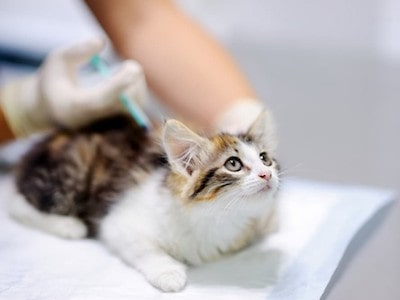
For adult cats, the frequency of FVRCP vaccination depends on several factors, such as the type of vaccine used (modified live or killed), the cat’s health status, lifestyle, and risk of exposure.
Some veterinarians recommend annual boosters for all cats, while others suggest every 3 years or longer intervals for low-risk indoor cats.
Your veterinarian can help you determine the best vaccination schedule for your cat based on their individual needs.
What are the possible side effects of the FVRCP vaccine?
Like any medical procedure, vaccination can have some side effects. However, most cats tolerate the FVRCP vaccine well, with minimal or no adverse reactions. The most common side effects are mild and short-lived, such as:
- Pain or swelling at the injection site
- Lethargy or reduced appetite
- Mild fever
- Sneezing or nasal discharge
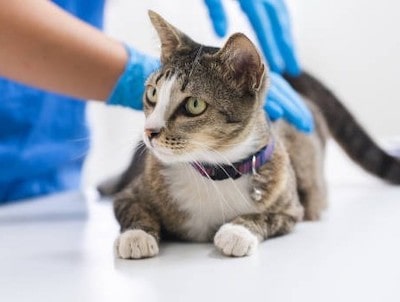
These side effects usually resolve within a day or two after vaccination. You can monitor your cat for any signs of discomfort or distress, and provide them with plenty of water and a comfortable place to rest. You can also contact your veterinarian if you have any concerns or questions about your cat’s reaction to the vaccine.
In rare cases, some cats may develop more serious side effects from the FVRCP vaccine, such as:
- Allergic reaction (anaphylaxis), which may cause difficulty breathing, vomiting, diarrhea, collapse, or shock
- Injection site sarcoma (ISS), which is a type of cancer that can develop at the site of vaccination
- Vaccine-associated feline sarcoma (VAS), which is a type of cancer that can develop anywhere in the body after vaccination
- Immune-mediated disease (IMD), which is a condition where the cat’s immune system attacks its own tissues or organs
These side effects are very uncommon, but they can be life-threatening if not treated promptly. If you notice any signs of these side effects in your cat, such as swelling, lumps, bleeding, ulcers, or abnormal behavior, you should seek immediate veterinary attention. Your veterinarian can diagnose and treat these conditions, and also report them to the vaccine manufacturer and regulatory authorities.
The risk of these serious side effects is very low compared to the risk of the diseases that the FVRCP vaccine prevents. However, you should always weigh the benefits and risks of vaccination with your veterinarian, and follow their recommendations on how to reduce the chances of adverse reactions. Some of these recommendations may include:
- Choosing the right type and brand of vaccine for your cat
- Using the minimum effective dose and frequency of vaccination
- Avoiding unnecessary or overlapping vaccines
- Administering the vaccine in a specific location on the body
- Using antihistamines or steroids before or after vaccination
- Monitoring your cat closely after vaccination and reporting any problems
FAQ
How often does my adult cat need a FVRCP vaccine?
After the initial kitten vaccination series, adult cats should receive a booster shot one year later. Depending on the type of vaccine used and your cat’s lifestyle, subsequent booster shots are typically administered every one to three years.
Can indoor cats skip the FVRCP vaccination since they don’t go outside?
Even indoor cats should receive the FVRCP vaccination. While outdoor cats are more exposed to disease-causing agents, viruses can still be brought into your home on shoes, clothing, or other pets. Ensuring your indoor cat is vaccinated provides an added layer of protection and prevents potential outbreaks.
Are there any cats who should not receive the FVRCP vaccine?
Cats with certain medical conditions or a history of severe vaccine reactions may not be suitable candidates for the FVRCP vaccination. Additionally, very young kittens and cats with weakened immune systems may need to delay vaccination. Your veterinarian can evaluate your cat’s health and determine the best course of action.
Can my cat still get the diseases even if she’s vaccinated?
While the FVRCP vaccine is highly effective, it does not guarantee 100% protection. In some cases, a vaccinated cat may still contract a disease, but the symptoms are usually milder than in unvaccinated cats. The vaccine greatly reduces the severity of the disease and improves the cat’s chances of recovery.
Conclusion
The FVRCP vaccine is a vital part of your cat’s preventive health care. It protects your cat from three serious viral diseases that can cause severe illness or death. It is recommended for all cats, regardless of their lifestyle or risk factors.
It is usually given to kittens as a series of shots, and then to adult cats at regular intervals. Most cats tolerate the vaccine well, with minimal or no side effects. However, some cats may develop rare but serious side effects that require immediate veterinary attention.
You should always consult with your veterinarian about the best vaccination schedule and protocol for your cat, and follow their advice on how to reduce the risk of adverse reactions.
By vaccinating your cat against these diseases, you are not only protecting your cat’s health, but also contributing to the welfare of the cat population.
Reference:
- Kuehn, N. F. (2023, July 19). Feline Respiratory Disease Complex (Feline Viral Rhinotracheitis, Feline Calicivirus). Merck Veterinary Manual.
- Truyen, U., Egberink, H., Frymus, T., Gruffydd-Jones, T., & Hartmann, K. (2009, July 1). Feline Panleukopenia: ABCD Guidelines on Prevention and Management. Journal of Feline Medicine and Surgery – Sage Journals

